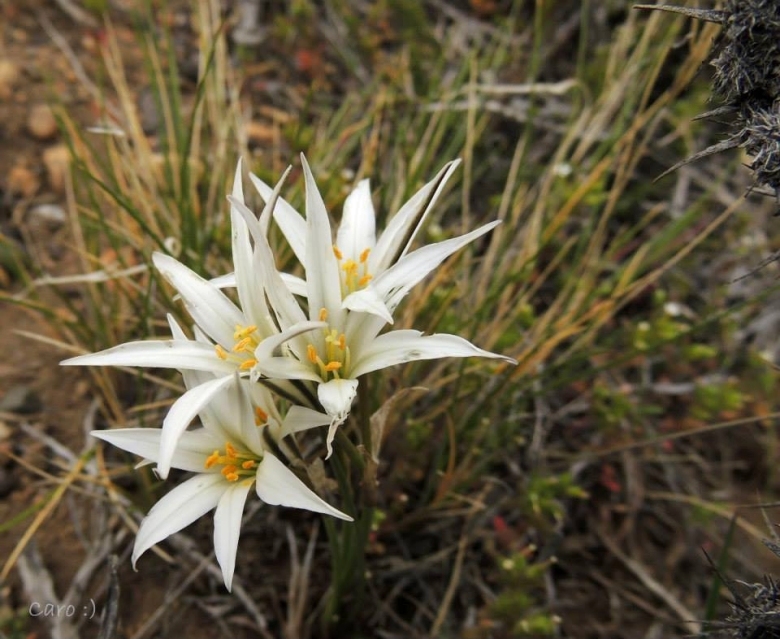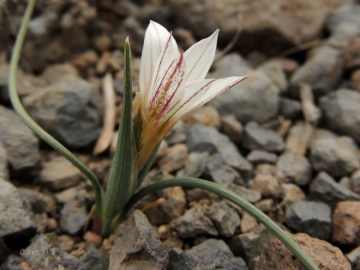
Tristagma patagonicum Photo by: Carolina González
Origin and Habitat: Argentina, from southern central cordilleras to the tip of Patagonia (provinces of Chubut, Neuquen, and Rio Negro).
Habitat and ecology: It grows on bare soil near the snow melt zone at 300-2000 metres above sea level according to latitude. It is locally common and abundant, under shrubs of Colliguaja integerrima Gillies et Hook.
Synonyms:
See all synonyms of Tristagma patagonicum
back
Accepted name in llifle Database:Tristagma patagonicum (Baker) TraubPl. Life 19: 61 (1963)Synonymy: 15
back
Common Names include:
SPANISH (Español): Estrellita, Estrellita blanca, Estrellita del campo
Description: Tristagma patagonicum (Brodiaea patagonicaSN|30861]]SN|30861]]) is a perennial bulbous herb 7-9 cm high with conspicuous white flowers blooming in the mountains when spring comes. The plants recover from the ravages of winter under the snow with only the smallest green shoots visible. Concerning the size of its flowers and tepals, T. patagonicum is quite variable.
Bulbs: Ovoid or oblong-oval, 16-20 mm long and 7-9 mm wide, provided with a thin neck 20-25 mm long.
Leaves: Few per bulb (1- to 2), linear, blunt-tipped, up to 6-8 cm long and 0.7-1.8 mm wide, margin entire, smooth or glabrous.
Flowers: Hermaphrodite, white, actinomorphic, solitary or in twos on a 45-80 mm long scape. Spate clamshell-like, bracts white, somewhat striated lanceolate, about 19 mm long and 2-3 mm wide, united at the base for ca. 2 mm. Pedicels 2-40 mm long. Flower erect, white with a dark stripe on the back of each tepal lobe, about 12 mm long and 10-35 mm in diameter. Tepals acute or obtuse fused at the base for 11 to 20 mm, then spreding, the exteriors 10-15 mm long and 2-6 mm wide, the interiors of 8.5-10 mm long and 2-6 mm wide. Filaments 6, thin, the episepalous inserted at 3-5 mm from the base of the tube forming the sepals, the epipetalous adnate to the corolla for 5-6 mm of the base and 3.5-5.5 mm long. Anthers somewhat recurved yellow, 1 mm long. Ovary oblong 2.6 to 3 mm long and 0.9 to 1.5 mm in diameter. Style threadlike 5-8 mm long, stigma with enlarged and globose lobes.
Fruits Capsules.
Similar species: The showiest and most garden-worthy species Tristagma anemophila is similar, but bearing flowers no more than 14 mm across with almost linear tepal-lobes. Some authorities consider it a variety of T. patagonicum.
Bibliography: Major references and further lectures
1) The Alpine Garden Society “Tristagma patagonicum” <http://encyclopaedia.alpinegardensociety.net> Web. 21 Mar. 2015.
2) Luis Faúndez Y. and Jorge H. Macaya B. “NUEVOS REGISTROS PARA LA FLORA DE CHILE: MAGALLANA PORIFOLIA CAV. (TROPAEOLACEAE), TRISTAGMA AMEGHINOI (SPEG.) SPEG. Y TRISTAGMA PATAGONICUM (BAKER) TRAUB (ALLIACEAE) NEW RECORDS FOR THE FLORA OF CHILE: MAGALLANA PORIFOLIA CAV., TRISTAGMA AMEGHINOI (SPEG.) SPEG. AND TRISTAGMAPATAGONICUM (BAKER) TRAUB” Gayana. Botánica versión On-line ISSN 0717-6643 Gayana Bot. v.57 n.1 Concepción 2000 <http://dx.doi.org/10.4067/S0717-66432000000100008>
 Tristagma patagonicum Photo by: Carolina González
Tristagma patagonicum Photo by: Carolina González Tristagma patagonicum Photo by: Carolina González
Tristagma patagonicum Photo by: Carolina González Tristagma patagonicum Photo by: Carolina González
Tristagma patagonicum Photo by: Carolina GonzálezSend a photo of this plant.The gallery now contains thousands of pictures, however it is possible to do even more. We are, of course, seeking photos of species not yet shown in the gallery but not only that, we are also looking for better pictures than those already present.
Read More... Cultivation and Propagation: Tristagma patagonicumSN|30858]]SN|30858]] is seldom grown but relatively easy to grow. It is dormant in summer in the wild, many but grows in areas with year round rainfall and may benefit from some summer moisture. It is certainly a beautifully delicate plant that merits cultivation. Lots of light and good drainage are a must.
Soil: It should be potted in a mixture of peat sand and loam and protected in a cold frame.
Water: Do not over water. In cultivation the slightest careless moisture in the winter produces disaster.
Maintenance: Deadhead the flowers and only keep the seed pods you will require for further propagation of your tristagmas. This will prevent the bulb to age too soon.
Use: They make superb rock garden plants, as well as being perfect for pots and containers.
Propagation: It may be propagated by offsets and probably by seeds. Sow them during autumn, in a mix of equal parts of compost, regular garden soil and sharp river sand. Cover this mix with a layer of sand, distribute the seeds and spread some more sand over them to barely cover the seeds. Place your sowing pan in a cold frame or cold greenhouse if you have heavy rain in your area. If you have snow, place the sowing pan outdoors and let nature do its work. The seedlings can be transplanted once they are 5 cm tall.












